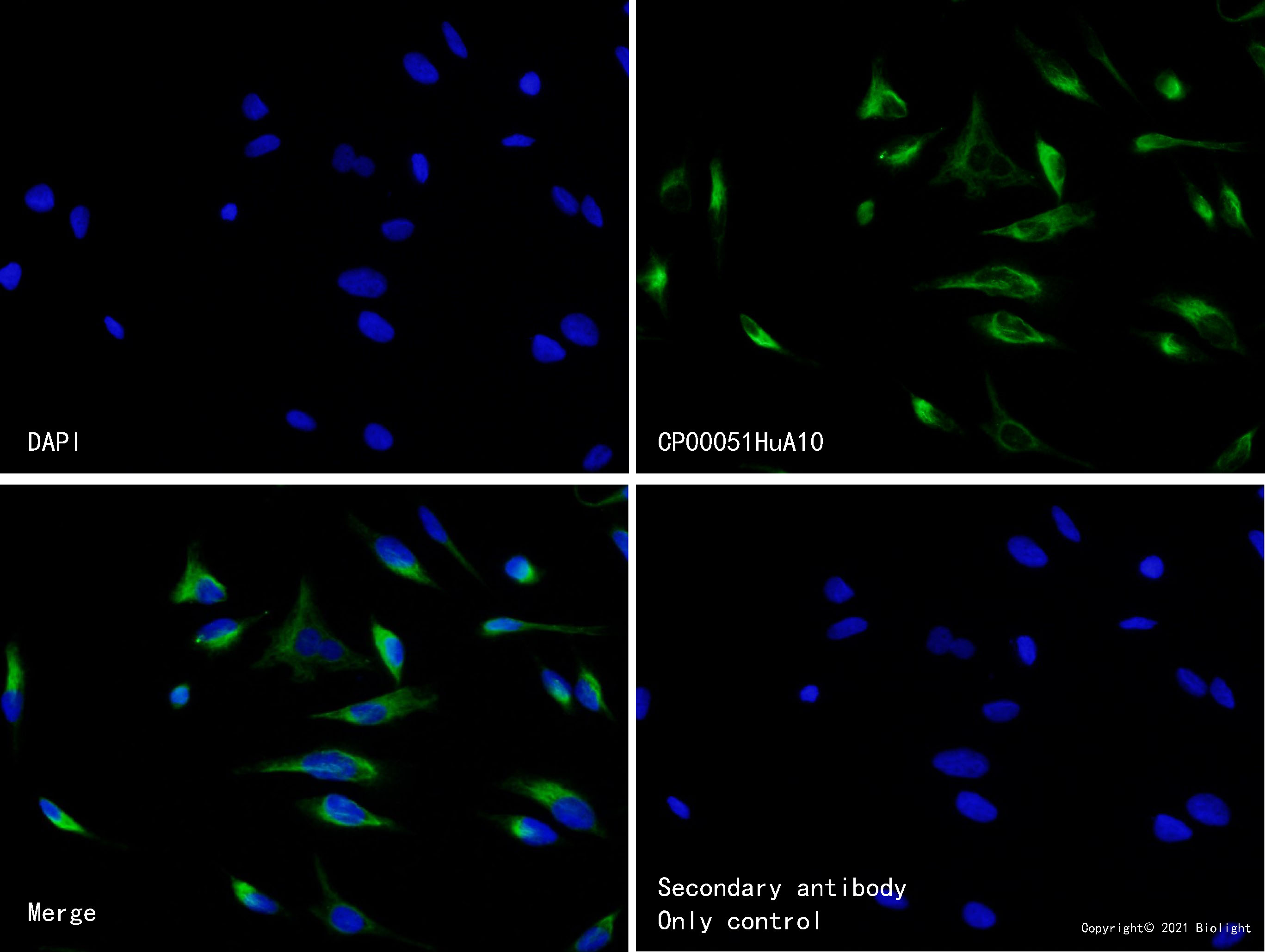
產(chǎn)品名稱:Anti-VIM Antibody, Rabbit Polyclonal
經(jīng)驗(yàn)證的應(yīng)用:WB/IHC/IF/ICC
交叉反應(yīng):Human/Mouse
特異性:human VIM
免疫原:Recombinant human VIM protein, fragment Ser2~Glu 466; UniprotKB: P08670
制備方法:Produced in rabbits immunized with human VIM, and purified by antigen affinity chromatography.
來源:Polyclonal Rabbit IgG
純化:Immunogen affinity purified
緩沖液:Supplied in PBS, 50% glycerol and less than 0.02% sodium azide, PH7.4
偶聯(lián)物:Unconjugated
狀態(tài):Liquid
運(yùn)輸方式:This antibody is shipped as liquid solution at ambient temperature. Upon receipt, store it immediately at the temperature recommended.
儲存條件:This antibody can be stored at 2℃-8℃ for one month without detectable loss of activity. Antibody products are stable for twelve months from date of receipt when stored at -20℃ to -80℃. Preservative-Free. Avoid repeated freeze-thaw cycles.
圖片:
Figure1.Application in WB
Figure2.Application in ICC
Immunocytochemistry analysis of U-87MG (Human astroblastoma cell) cells labeling VIM with purified PA00051HuA10 at 5μg/mL. Cells were fixed in 4% Paraformaldehyde and permeabilized with 0.1% tritonX-100. Goat anti-rabbit IgG (Alexa Fluor® 488, GB25303) was used as the secondary antibody at 1/1000 (2μg/mL) dilution. DAPI (blue) was used as nuclear counterstain. PBS instead of the primary antibody was used as the secondary antibody only control.
Figure3.Application in IHC
別稱:CTRCT30, Epididymis luminal protein 113, FLJ36605, HEL113, OTTHUMP00000019224, VIM, VIME_HUMAN, Vimentin.
背景信息:Vimentin. Vimentin is a 57 kDa class III intermediate filament (IF) protein that belongs to the intermediate filament family. It is the predominant IF in cells of mesenchymal origin such as vascular endothelium and blood cells (1-3). The human Vimentin cDNA encodes a 466 amino acid (aa) protein that contains head and tail regions with multiple regulatory Ser/Thr phosphorylation sites, and a central rod domain with three coiled-coil regions separated by linkers (1, 2). Human Vimentin shares 97-98% aa identity with mouse, rat, ovine, bovine and canine Vimentin. Sixteen Vimentin coiled-coil dimers self-assemble to form intermediate (10-12 nm wide) filaments (4). These filaments then anneal longitudinally to form non-polarized fibers that support cell structure and withstand stress (4). IF fibers are highly dynamic, and half-life depends on the balance between kinase and phosphatase activity. For example, phosphorylation followed by dephosphorylation drives IF disintegration, followed by reorganization during mitosis (1, 5, 6). Interactions of head and tail domains link IFs with other structures such as actin and microtubule cytoskeletons (7). Vimentin is involved in positioning autophagosomes, lysosomes and the Golgi complex within the cell (8). It facilitates cell migration and motility by recycling internalized trailing edge integrins back to the cell surface at the leading edge (9-11). Vimentin helps maintain the lipid composition of cellular membranes, and caspase cleavage of Vimentin is a key event in apoptosis (8, 12). Phosphorylation promotes secretion of Vimentin by TNF-alpha -stimulated macrophages (13). Extracellular Vimentin has been shown to associate with several microbes, and appears to promote an antimicrobial oxidative burst (13, 14). Cell-associated Vimentin can also interact with NKp46 to recruit NK cells to tuberculosis-infected monocytes (15).
全稱:Vimentin (VIM)




